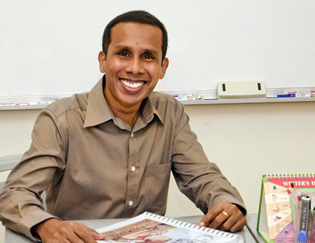Why Singapore’s English Teachers Should Embrace Singlish, Not Fight It
Is it time for Singaporean educators to embrace Singlish as a legitimate learning tool? What the Research […]
Read More
As a student, Mr Jeyaram Kadivan used to dread English Language lessons. He struggled with the language and even failed the subject in school. Today, he helps young people to find a love for the language and to succeed where he failed.
Jeyaram – or Mr Ram, as he is known in school – is an Allied Educator (AED) at St Gabriel’s Secondary School, which is a resource school for dyslexia support.
Ram’s role is to support students with this learning disability and the teachers who teach them. He advises teachers, helps in classroom teaching, and also conducts one-to-one or small-group intervention programmes to help those with more challenging learning needs.
 Students with dyslexia hate to read or write. Because this group of learners often has difficulties comprehending what they read, the first thing Ram tries to do is to create a love for language in them.
Students with dyslexia hate to read or write. Because this group of learners often has difficulties comprehending what they read, the first thing Ram tries to do is to create a love for language in them.
“Children with special needs tend to fall backwards because despite them getting all that support, it may not be that concrete,” he notes. To get them to learn and improve, he needs to increase their motivation. “They need to see success in their work,” he says.
Ram carefully designs a variety of materials to help them grasp both the content and literacy skills. To make sure they don’t lag behind their peers, he chooses topics that are aligned with the English Language curriculum.
So if the topic is advertisements, they may get a cloze passage and a comprehension passage about ads. They’ll also look at ads, talk about them, and even design their own.
It may take up to 4 weeks to complete a topic, but Ram is in no hurry. He takes his time to make sure his learners understand the topic and to make it meaningful to them.
“The philosophy I adopt is that they don’t get homework here. It’s fun,” shares Ram. “I really go at their level and take time to finish every period.”
While his work is specialized, Ram has always adopted an all-encompassing approach: “Support everyone as much as possible.”
Sometimes, it turns out that some of those identified as special needs students don’t have a learning disability but a learning difficulty.
– Mr Jeyaram Kadivan, St Gabriel’s Secondary School
“Because they come from a family where their mother tongue is the most utilized language at home, that becomes an issue in school. Because they are not conversing in English, and because our teaching mode is all in English, they are struggling.”
Ram found that a “universal” approach to teaching and learning is useful for students like these. Research in “universal design for learning” (or UDL) has shown that curriculum materials designed for special needs students can also be used for the general student population, and everyone can benefit from it.
It’s really about teaching at the level of the student and communicating knowledge in a way that they can relate to and understand.
“It’s useful for Normal (Technical) classes, where there are that small group of kids who are falling through the sieve, where they are not really diagnosed with a disability. But it’s going to benefit them because it’s so simplified and concrete, and the terms used are based on the curriculum,” explains Ram.
It wasn’t until much later that he learned that researchers have given this approach a name. “We were naturally doing it, but we never knew there was a full-blown model and philosophy behind it.”
As an AED, Ram is not trained to teach. His primary role is to support teaching and learning. To better equip himself, Ram took up a course on teaching English by the British Council last year. He also reads up on learning strategies and research materials to stay up-to-date.
– Ram on his approach to teaching
“I felt that I really needed to know curriculum to teach them what they need. It’s not just about giving them a tool and saying, ‘You have to do this,’ but why they are doing it, how they are doing it. You really have to scaffold them and do it step by step.”
Ram is also involved in the school’s professional learning community (PLC). “I work closely with the Secondary 1 and 2 teachers in the English department, to understand what the changes in curriculum are. That keeps me abreast about what’s happening and how I can prepare these boys for the new information that they require.”
This understanding helps him to better differentiate the materials he designs for his students, to cater to their specific ways of learning.Ram has found it helpful to share the load with fellow teachers in the PLC or school cluster. He recently collaborated with three others schools to design lesson materials. “We were sharing resources, and now I have Secondary 1 to 4 materials with me but I only did one set!”
It takes a lot of commitment but the effort pays off long into the future. “It’s basically the mindset,” stresses Ram. “You have to start small. The initial stage will always be very difficult, but as you develop the material, it’s saved up in your bank and you can utilize it again.”
Useful Resources